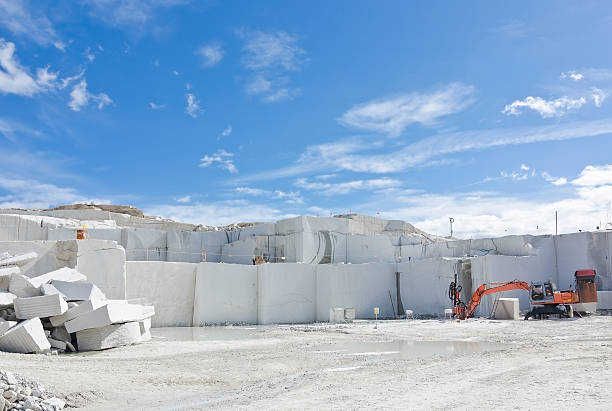The Covert Gems: Exploring Granite Quarries in South Africa
The Covert Gems: Exploring Granite Quarries in South Africa
Blog Article
Revealing the Mysteries of Granite Quarrying: Where Toughness and Elegance Meet
The world of granite quarrying is a world where the raw toughness of nature converges with human virtuosity to create structures that stand the examination of time with an air of elegance. From the depths of quarries to the careful sprucing up in workshops, the procedure of transforming granite into architectural wonders is an intricate dance of custom and advancement. As we peer right into the midsts of this ancient craft, we begin to uncover the concealed details that form the really essence of our built atmosphere.
The Beginnings of Granite Quarrying
In the record of building background, the beginnings of granite quarrying are shrouded in a tapestry of old workmanship and geological wonders. Going back to old Egypt and Mesopotamia, the removal of granite from quarries noted the start of a trip that would at some point lead to the creation of some of the world's most iconic structures.
Granite quarrying's roots can be traced to the experienced artisans who recognized the stone's sturdiness and aesthetic appeal. Through a combination of primitive devices and large resolution, these very early quarry employees discovered granite blocks that would become the structure blocks of people.
As civilizations evolved, so did the techniques of quarrying granite. The Romans, renowned for their design expertise, established sophisticated methods for extracting granite to create monoliths, temples, and roadways that stood the examination of time.
The tradition of these ancient quarrying practices remains to form contemporary architecture, with granite remaining an icon of stamina and beauty in construction jobs around the globe. (granite quarries in south africa)
Devices of the Quarrying Profession
The development of granite quarrying techniques from old worlds to modern times highlights the critical duty played by the tools of the quarrying trade in forming the industry's practices. In old times, quarrying tools were rudimentary, usually including chisels, hammers, and wedges made from products like bronze or iron. These tools called for significant workforce and time to essence granite obstructs from quarries.

In addition, the intro of pneumatically-driven devices and straight from the source high-powered equipment has actually significantly reduced the physical labor required in quarrying operations, enhancing worker safety and security and performance. As the quarrying sector proceeds to introduce, the devices of the profession continue to be at the center of driving progression and forming the future of granite removal.
Drawing Out Blocks of Granite
Making use of precision machinery and progressed methods, the removal of granite obstructs from quarries has come to be an advanced process in the modern-day quarrying market. Controlled blowing up techniques are after that employed to damage apart the granite into convenient sections.

Sprucing Up and Ending Up Methods
To attain a perfect surface area on granite blocks, experienced craftsmens employ a collection of meticulous sprucing up and ending up methods. After the first official statement extraction and shaping procedures, the granite blocks go through a thorough polishing stage to boost their natural appeal and durability.
In addition to sprucing up, finishing methods are related to further fine-tune the granite's look. These strategies may include flaming, refining, or cleaning, each offering unique structures and surfaces to you could look here match different aesthetic preferences. Flaming, as an example, entails exposing the granite surface to heats to produce a harsh, distinctive coating, suitable for outside applications where slip-resistance is crucial. Honing, on the other hand, offers a matte surface that is smooth to the touch, perfect for interior countertops and floor covering. By very carefully selecting and applying these polishing and finishing strategies, craftsmens can transform raw granite blocks into beautiful pieces that display both stamina and beauty.

Ecological Influence and Sustainability
With the expanding emphasis on environmental consciousness in the industry, granite quarrying methods are increasingly looked at for their effect on all-natural resources and lasting sustainability. Quarrying for granite can have significant ecological effects. The extraction procedure frequently entails making use of hefty equipment, explosives, and large quantities of water, leading to habitat devastation, soil erosion, and water air pollution. Additionally, the transportation of granite from quarries to refining centers generates carbon discharges, better contributing to environmental destruction. granite quarries in south africa.
To reduce these effects and make certain sustainability in granite quarrying, sector stakeholders are adopting various steps. Carrying out innovative modern technologies to lower power intake and water use, reclaiming quarried land for ecological restoration, and promoting responsible sourcing practices are some strategies being employed. Moreover, accreditations such as the Forest Stewardship Council (FSC) and the Leadership in Energy and Environmental Design (LEED) help customers recognize eco-friendly granite items.
Verdict
To conclude, granite quarrying is a process that calls for specialized devices and techniques to remove blocks of granite and polish them to a high degree of surface. While the environmental influence of quarrying can be considerable, initiatives are being made to enhance sustainability practices in the sector. On the whole, granite quarrying is a fragile balance between harnessing the stamina and style of this natural rock while lessening its effect on the atmosphere.
Report this page